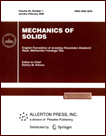 | | Mechanics of Solids
A Journal of Russian Academy of Sciences | | Founded
in January 1966
Issued 6 times a year
Print ISSN 0025-6544
Online ISSN 1934-7936 |
Archive of Issues
| Total articles in the database: | | 13362 |
| In Russian (Èçâ. ÐÀÍ. ÌÒÒ): | | 8178
|
| In English (Mech. Solids): | | 5184 |
|
| << Previous article | Volume 60, Issue 4 / 2025 | Next article >> |
| Shuangqing Qian, Yingwei Xu, Yanyu Hu, Yanfeng Niu, Tianyi Gu, Jinyao Nie, Fubao Zhang, Susu Liu, and Jie Zhou, "Influence of Interlayer Mixing Ratio on the Anti-Penetration Performance of kevlar/uhmwpe Target Plate," Mech. Solids. 60 (4), 3258-3270 (2025) |
| Year |
2025 |
Volume |
60 |
Number |
4 |
Pages |
3258-3270 |
| DOI |
10.1134/S0025654425601806 |
| Title |
Influence of Interlayer Mixing Ratio on the Anti-Penetration Performance of kevlar/uhmwpe Target Plate |
| Author(s) |
Shuangqing Qian (School of Mechanical Engineering, Nantong University, Nantong, 226019 China)
Yingwei Xu (School of Mechanical Engineering, Nantong University, Nantong, 226019 China)
Yanyu Hu (School of Mechanical Engineering, Nantong University, Nantong, 226019 China)
Yanfeng Niu (School of Mechanical Engineering, Nantong University, Nantong, 226019 China)
Tianyi Gu (School of Mechanical Engineering, Nantong University, Nantong, 226019 China)
Jinyao Nie (School of Mechanical Engineering, Nantong University, Nantong, 226019 China)
Fubao Zhang (School of Mechanical Engineering, Nantong University, Nantong, 226019 China)
Susu Liu (School of Mechanical Engineering, Nantong University, Nantong, 226019 China)
Jie Zhou (School of Mechanical Engineering, Nantong University, Nantong, 226019 China, jiezhou@ntu.edu.cn) |
| Abstract |
Based on existing ballistic penetration experimental studies, this work investigates the antipenetration performance of interlayer hybrid composite panels composed of kevlar and uhmwpe (ultra-high-molecular-weight polyethylene). The results validate that Kevlar exhibits superior suitability as the impact-facing layer compared to uhmwpe. Building on this finding, we employed ballistic limit velocity test and numerical simulation methods to analyze the damage modes and anti-penetration performance of panels penetrated by 1.1 g fragments. Additionally, the penetration process was simulated using Ls-dyna, enabling the prediction of interlayer hybrid ratios with superior anti-penetration performance under three specific conditions. The underlying mechanisms were further elucidated. The results showed that under the condition of equal areal density, the hybrid composite panel with kevlar as the impact-facing layer mixed with uhmwpe demonstrates enhanced anti-penetration performance when the mass ratio of kevlar to uhmwpe is approximately 25%. Under the condition of identical layer count, the panel achieves superior ballistic resistance when the mass ratio of kevlar to uhmwpe reaches 70%. Under the condition of constant thickness, the optimal anti-penetration performance is observed when the mass ratio of kevlar to uhmwpe is 53%. Using materials with high shear strength on the surface layer of the target plate and materials with high tensile strength and high elongation at break on the back layer can better enhance the synergistic effect between the hybrid composite material layers. |
| Keywords |
anti-penetration performance, ballistic limit velocity, finite element simulation, impact simulation, composite material |
| Received |
16 April 2025 | Revised |
23 May 2025 | Accepted |
10 June 2025 |
| Link to Fulltext |
|
| << Previous article | Volume 60, Issue 4 / 2025 | Next article >> |
|
 If you find a misprint on a webpage, please help us correct it promptly - just highlight and press Ctrl+Enter If you find a misprint on a webpage, please help us correct it promptly - just highlight and press Ctrl+Enter
|
|

 Russian
Russian  English
English